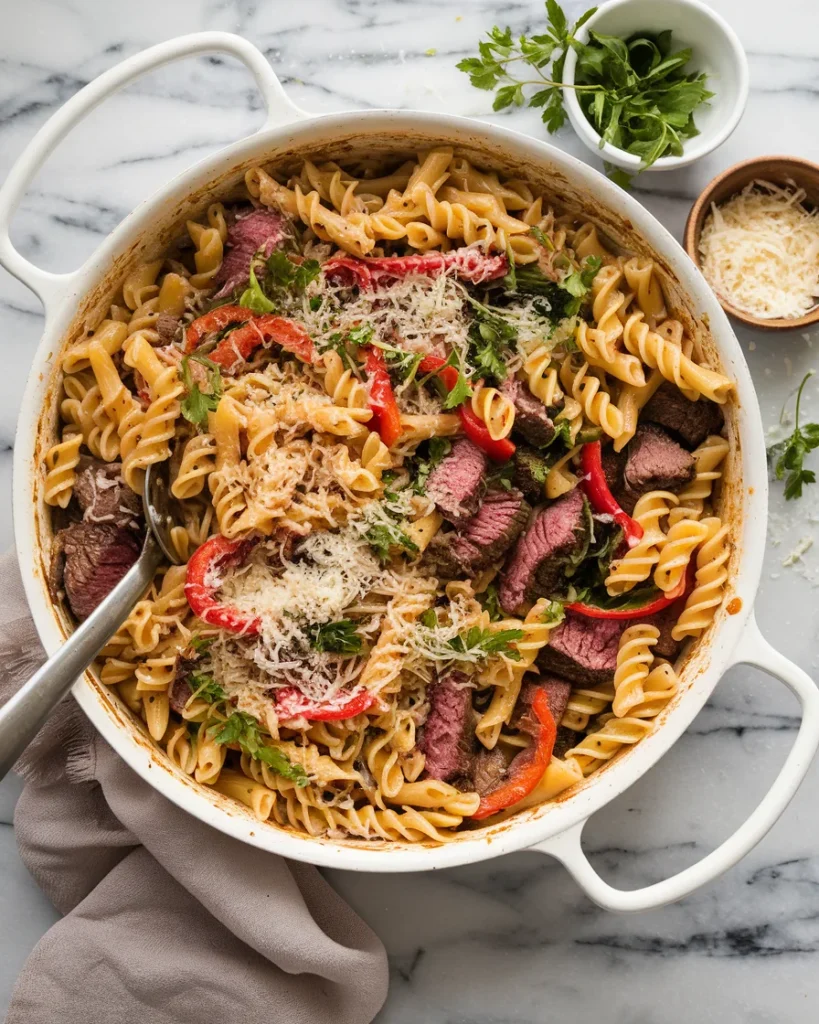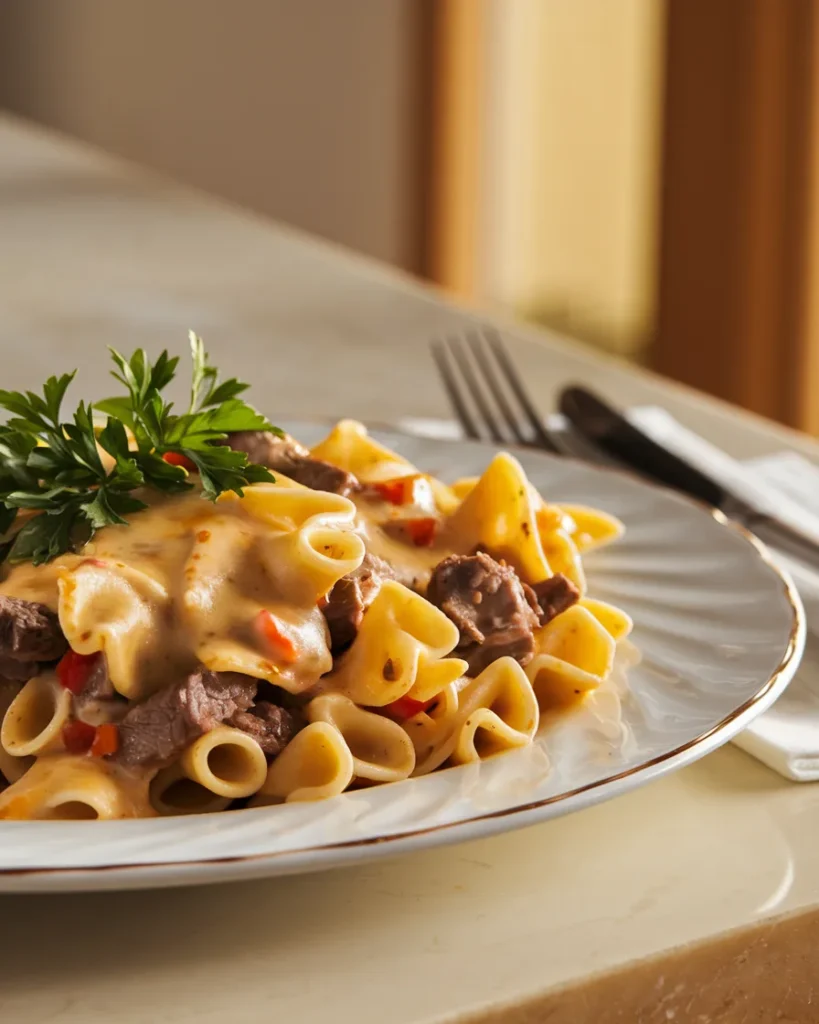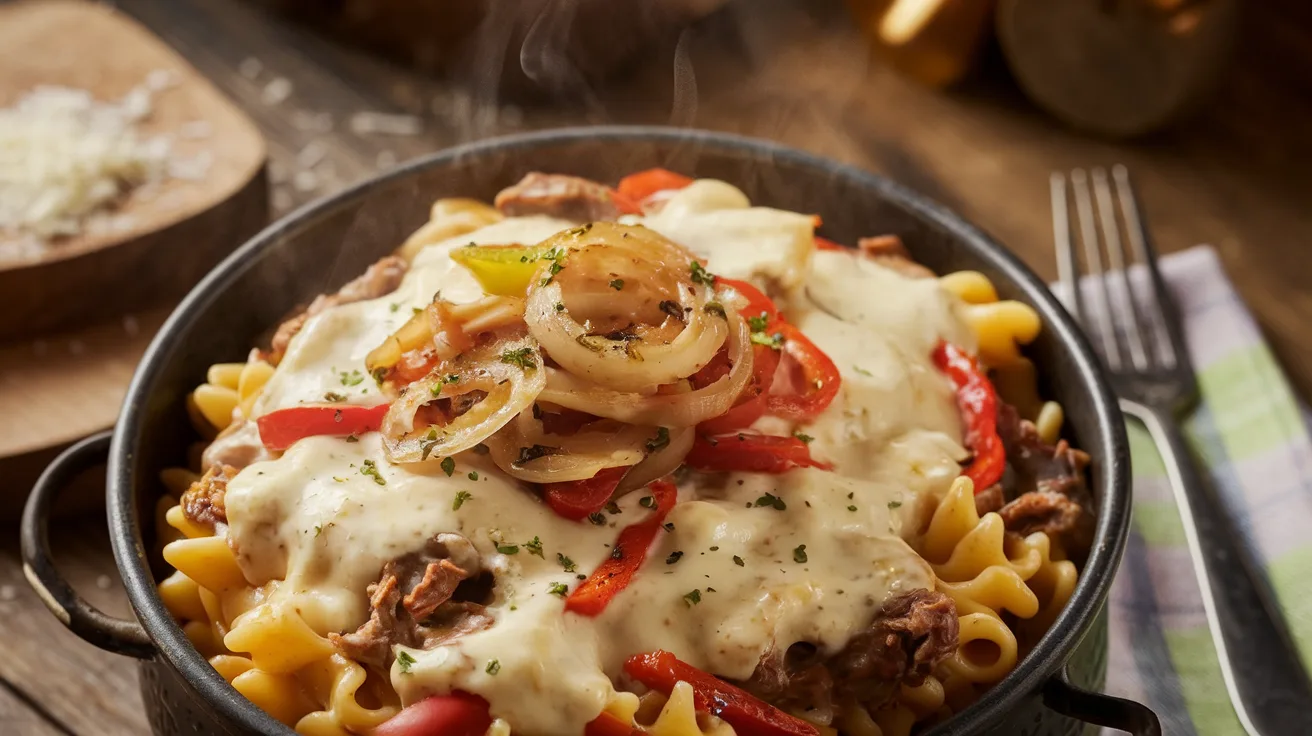Everything You Need to Know About Philly Cheesesteak Pasta
Philly Cheesesteak Pasta is the ultimate comfort food—a delicious union of two beloved favorites. By combining the bold, savory flavors of Philly cheesesteak with the hearty texture of pasta, this dish has won the hearts of foodies everywhere. Whether you’re a fan of the original sandwich or just love trying unique recipes, this guide will walk you through everything from its origin to the perfect way to serve it. Let’s dive into this flavorful adventure, starting with its roots.
Introduction to Philly Cheesesteak Pasta
What is Philly Cheesesteak Pasta?
Philly Cheesesteak Pasta is a fusion dish inspired by the iconic Philly cheesesteak sandwich. The classic sandwich, loaded with thinly sliced beef, sautéed onions, and gooey cheese, finds a new home in a comforting pasta dish. Imagine tender pieces of steak, sweet bell peppers, and melted cheese tossed in perfectly cooked pasta—mouthwatering, right?
How This Recipe Combines Two Favorites
This recipe combines the best parts of two iconic dishes: the rich, meaty filling of a Philly cheesesteak and the satisfying heartiness of pasta. It’s a clever twist that transforms the sandwich into a one-pot dinner that’s both filling and flavorful. Plus, it’s easy to prepare and perfect for weeknight meals or a cozy weekend treat.
The Origins of Philly Cheesesteak and Its Pasta Twist
The History of the Classic Philly Cheesesteak
The Philly cheesesteak has a rich history that began in the streets of Philadelphia in the 1930s. Legend has it that Pat Olivieri, a hot dog vendor, created the sandwich by throwing thinly sliced beef on his grill, catching the attention of a cab driver who asked for a bite. That simple act sparked the beginning of what would become an American culinary icon. Over time, the sandwich evolved to include sautéed onions, melted cheese, and a crusty hoagie roll.
Philadelphia locals took pride in this creation, which quickly became a must-try dish for visitors. The cheesesteak’s popularity spread across the country, spawning countless variations. While the original remains the gold standard, creative twists like Philly Cheesesteak Pasta showcase just how versatile the dish can be.
How Pasta Became a Unique Adaptation
Pasta is no stranger to fusion dishes. Adding pasta to Philly cheesesteak ingredients creates a meal that’s comforting and hearty without straying too far from the original concept. The buttery, tender noodles perfectly complement the savory beef and creamy cheese. Plus, the addition of pasta makes this dish easier to serve at family dinners or potlucks—no messy sandwich rolls to worry about!
This creative spin has gained traction because it retains the bold flavors of the cheesesteak while offering a new way to enjoy it. From busy home cooks to food bloggers, Philly Cheesesteak Pasta has become a staple in kitchens everywhere.
Key Ingredients for Philly Cheesesteak Pasta
Core Ingredients: Beef, Peppers, and Cheese
At the heart of Philly Cheesesteak Pasta are three essential ingredients: beef, peppers, and cheese. Thinly sliced steak, such as ribeye or sirloin, ensures tender, flavorful bites. Bell peppers, typically green and red, add a slight sweetness that balances the dish’s richness. For the cheese, provolone and cream cheese are common choices, creating a smooth, velvety sauce that ties everything together.
Choosing the Right Type of Pasta
Not all pasta is created equal when it comes to this dish. Short pasta shapes like penne, rigatoni, or farfalle work best because they can hold the sauce and ingredients in every bite. Their sturdy texture pairs well with the meaty filling, making each forkful satisfying.
Recommended Seasonings and Sauces
To capture the authentic flavors of a cheesesteak, simple seasonings are key. A mix of garlic powder, black pepper, and paprika brings out the natural taste of the beef and vegetables. Worcestershire sauce, a pantry staple, adds a subtle umami flavor that mimics the essence of a classic cheesesteak. Combined with the cheesy sauce, these seasonings create a well-rounded dish that’s hard to resist.
Step-by-Step Recipe for Philly Cheesesteak Pasta
Preparing the Ingredients
The first step to making Philly Cheesesteak Pasta is gathering fresh ingredients. Start with thinly sliced steak, such as ribeye or sirloin, which ensures tender bites. For the vegetables, grab green and red bell peppers, onions, and minced garlic. To create the creamy sauce, you’ll need provolone or mozzarella cheese, cream cheese, and a splash of milk or heavy cream. Don’t forget your favorite short pasta, like penne or rigatoni, and seasonings like garlic powder, paprika, and Worcestershire sauce.
Cooking the Steak and Vegetables

Begin by searing the steak in a hot skillet with a drizzle of oil. Cook it until just browned, then set it aside. In the same pan, sauté the onions, peppers, and garlic until softened and fragrant. This step builds a rich, flavorful base for the dish. Stir in Worcestershire sauce to amplify the savory flavors, scraping up any bits stuck to the pan.
Assembling the Pasta Dish
While the vegetables cook, boil your pasta according to package instructions. Once it’s al dente, reserve a cup of pasta water before draining. Return the steak to the skillet, add the cooked pasta, and toss everything together. Slowly mix in the cheese and cream to create a velvety sauce. If needed, add a splash of the reserved pasta water to achieve your desired consistency.
Tips for Achieving Authentic Cheesesteak Flavor
For the best results, use freshly grated cheese, as it melts more smoothly. Keeping the steak slightly undercooked before combining it with the pasta prevents it from drying out. Also, don’t skimp on the Worcestershire sauce—it’s the secret to mimicking the authentic taste of a cheesesteak.

Variations and Substitutions for Philly Cheesesteak Pasta
Low-Carb or Gluten-Free Options
If you’re looking for a low-carb version, swap out the pasta for zucchini noodles or spaghetti squash. Gluten-free pasta made from rice or chickpeas is another excellent substitute, allowing you to enjoy the dish without the wheat.
Vegetarian and Vegan Adaptations
For a vegetarian twist, replace the steak with mushrooms or plant-based meat alternatives. Vegan cheese and almond milk can easily replace the dairy components, keeping the dish creamy and satisfying without animal products.
Creative Twists: Adding Mushrooms or Other Vegetables
Experimenting with additional ingredients is a great way to customize this recipe. Mushrooms are a popular choice, as they add depth and a meaty texture. You can also throw in spinach, broccoli, or even jalapeños for a spicy kick. Each variation brings its own flair while staying true to the comforting essence of Philly Cheesesteak Pasta.
For more delicious recipes, check out Marry Me Chicken Pasta Recipe for another irresistible pasta dish packed with flavor!
Expert Tips for the Perfect Philly Cheesesteak Pasta
Best Cooking Practices for Tender Steak
To achieve the best flavor and texture in Philly Cheesesteak Pasta, selecting the right cut of steak is essential. Ribeye or sirloin works wonders because of their marbling and tenderness. Always slice the steak thinly, against the grain, for a melt-in-your-mouth experience. When cooking the meat, use high heat to sear it quickly, locking in its juices. Overcooking can make the steak tough, so remove it from the pan as soon as it’s browned.
How to Avoid Overcooked Pasta
Nothing ruins a pasta dish faster than mushy noodles. To keep your pasta perfectly al dente, set a timer and check it a minute or two before the package suggests. Draining the pasta while it’s still firm allows it to finish cooking as you mix it with the sauce. Additionally, save a bit of pasta water—it’s a handy trick for adjusting the sauce consistency without watering down the flavor.
Getting the Perfect Cheese Melt
Cheese is the star of this dish, so it’s important to treat it right. Use freshly grated cheese for the best melting results. Pre-shredded cheese often contains anti-caking agents that can make the sauce grainy. When adding cheese to the skillet, lower the heat to avoid curdling, and stir slowly to create a smooth, creamy sauce.
Pairing Suggestions for Philly Cheesesteak Pasta
Best Side Dishes: Salads, Bread, and More

Serving Philly Cheesesteak Pasta with complementary sides can turn a simple meal into a feast. A crisp Caesar salad or a fresh garden mix pairs well, balancing the richness of the dish. For a more indulgent experience, garlic bread or a crusty baguette makes the perfect accompaniment. These sides soak up the cheesy sauce, leaving no bite behind.
Beverage Pairings to Enhance the Meal
The right drink can elevate your dining experience. For something classic, try a cold glass of iced tea or lemonade. If you prefer something bold, a glass of red wine like Merlot or Cabernet Sauvignon complements the dish’s hearty flavors. For beer lovers, a light lager or a hoppy IPA pairs nicely with the cheesy, savory notes of Philly Cheesesteak Pasta.
Frequently Asked Questions (FAQ) About Philly Cheesesteak Pasta
What Cheese Works Best for Philly Cheesesteak Pasta?
Cheese is the soul of Philly Cheesesteak Pasta, and several options work well. Provolone is the classic choice, offering a mild yet rich flavor. Mozzarella is another favorite, thanks to its gooey texture. For a sharper taste, you can mix in cheddar or Monterey Jack. Whichever cheese you choose, make sure it melts smoothly to create that signature creamy sauce.
Can This Recipe Be Made Ahead of Time?
Absolutely! Philly Cheesesteak Pasta is a great make-ahead dish. Prepare the pasta and sauce separately, then combine them before serving. Store leftovers in an airtight container in the fridge for up to three days. When reheating, add a splash of milk or broth to refresh the sauce’s creaminess.
What Are the Best Cuts of Meat to Use?
Thinly sliced ribeye is the traditional choice for Philly cheesesteak recipes, but sirloin or flank steak also works well. If you’re in a pinch, ground beef can be a quicker, more budget-friendly alternative.
How Long Does It Take to Prepare the Dish?
From start to finish, this recipe typically takes 30–40 minutes. The cooking time includes prepping the ingredients, cooking the steak and vegetables, and combining everything with the pasta and cheese sauce.
Can I Freeze Philly Cheesesteak Pasta?
Yes, you can freeze this dish for future meals. Store it in a freezer-safe container for up to three months. To reheat, thaw it overnight in the fridge and warm it on the stove, adding a bit of milk or broth to revive its creamy texture.
This concludes our guide to Philly Cheesesteak Pasta. Try this comforting dish and enjoy a blend of bold flavors and satisfying textures!

